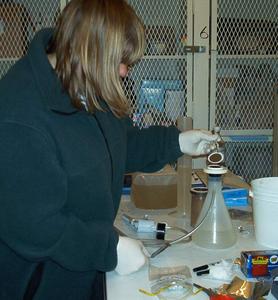27 April, 2003
Back at the Lab
Today in Kotzebue
The weather is still about 30 – 40 degrees and mostly cloudy.
The snow is starting to melt and making big lakes in the roads. The
water is pumped into the ocean, making for a bit of a puddle on the
ice that the snow machines are trying to avoid.
What science is happening?
Today we began the job of processing the samples we collected on
the ice. Of all the tests we conducted, we brought two things back
with us: Water, from the Neskin Bottle and Mud, from the mud grabs we
did both of those need to be processed
Water
1.) Take samples at the site with the Neskin Bottle and label
bottles with location collected. (did this yesterday)
2.) Put water into suction bottle and pump thought a filter.
(filter turns green)
3.) Filters are taken to North Carolina for testing.
What happens in North Carolina? The chlorophyll* is extracted from
the filters with acetone (similar to nail polish remover) and put into
a flurometer. A flurometer shines a light through the sample and
measures how much light comes is visible on the other side.
Question: What does this tell us?
Answer: This tells us how
much plant material present at this time of the year.
Why do we
need to know?
When we understand what and how much plants are in
the water, we can determine how much life can be supported.
Mud
1.) Take mud grabs with the bucket at the site and label bags with
location. (did this yesterday)
2.) Put mud in a sieve * and cover with seawater from the same
site. (Why do you think it is important to wash in water from the same
place?)
3.) When you have all the mud washed off, take out any visible
animals (small clams and worms) and put in labeled collection
bottle.
4.) Put the remainder of debris in collection bottle.
5.) Melinda fixes (colors and preserves) specimens so they can be
viewed later using formalyn and red coloring.
6.) The sea life is identified and counted under the
microscope.
Question: What does this tell us?
Answer: How much life is active
in the mud at this time of year
Question: Why do we need to know
this?
Answer: When we know “who’s home” at the bottom levels of the
food chain then we can predict what other life can flourish and what
effects things like an earlier spring that global warming is causing
will effect.
Classroom Connections:
It is the year 2050. Spring comes 4 weeks sooner every year.
Predict the changes in your community and in the global community.
Think about: What will happen to the polar ice caps
Where will
all the melt water go?
What will happen to birds migration patterns?
What about animals that hibernate?
What about insects that come
out in the spring? If there is 4 more weeks of hot weather how many
more will there be? Further, what about the animals that eat them?
What about energy costs? Will we need more or less?
Reflections
I find it
extremely interesting to be on the cusp of new knowledge. When I
found coronomids (small red worms) in mud samples, it surprised some
of the people in the lab. I know something that none else did,
something I couldn’t have read in any book, no matter how long I
looked. It made me understand why scientists want to learn more and
more.
Words to know
Chlorophyll - The green substance in
plants that gathers light from the sun.
Seive-A pan with the
screen at the bottom, to wash mud out of and collect small samples.
Links
Learn
more about our project here
View curriculum for this project, “Ask a Scientist” and
learn about other Arctic Real Time research at Arctic Alive
City of
Kotzebue Webpage
Listen to the local radio station KOTZ live

1.) When we grabbed the mud from the bottom of the lagoon, that was only the beginning of the process. Here I am seiving this mud to find out what is inside. It is a cold, messy, often smelly process. We found some clams and cornomids (small red worms) today. The contents is then put into little bottles number with the sight location.

2.) Once I get the mud seived and into bottles, Melinda fixes it (preserves and colors it, so she can see it). After a few weeks she will look at the sample under a microscope to count and catalog the different species.

3.) The water samples, taken yesterday with the Neskin Bottle, are put through a filter to collect the chlorophyll. Chlorophyll is the substance produced by plants (in this case algae). The filters are then taken to the lab in North Carolina, disolved with acetone and looked at through a flurometer. During our next visit in July, we will bring the flurometer with us and finish the samples at the lab in Kotzebue.
Contact the TEA in the field at
.
If you cannot connect through your browser, copy the
TEA's e-mail address in the "To:" line of
your favorite e-mail package.
|







